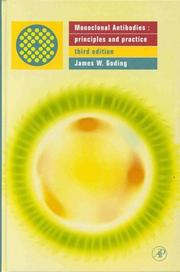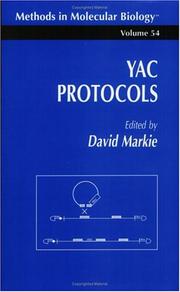| Listing 1 - 3 of 3 |
Sort by
|

ISBN: 0122870239 9786611025922 1281025925 0080536956 9780122870231 9780080536958 Year: 1996 Publisher: London ; San Diego : Academic Press,
Abstract | Keywords | Export | Availability | Bookmark
 Loading...
Loading...Choose an application
- Reference Manager
- EndNote
- RefWorks (Direct export to RefWorks)
Monoclonal Antibodies now have applications in virtually all areas of biology and medicine, and much of the world's biotechnology industry has its foundations in the exploitation of this technology.The Third Edition of this well established book meets the needs of both newcomers to the area and experienced researchers, by providing an integrated treatment of both the production and application of monoclonal antibodies. As in previous editions, detailed and critical accounts of the theory, production, purification, fragmentation, storage and radiolabelling of monoclonal antibodies ar
Monoclonal antibodies --- Biotechnology. --- Diagnostic use. --- Monoclonal antibodies. --- Immunoglobulins. --- Antibodies --- Immune globulins --- Immune serum globulin --- Blood proteins --- Globulins --- Plasma cells --- Antibody diversity --- Antigens --- Bacterial immunoglobulin-binding proteins --- Antibodies, Monoclonal --- Monoclonal immunoglobulins --- Immunoglobulins --- Molecular cloning

ISBN: 9780896033139 0896033139 9781592595419 9786610836635 1280836636 1592595413 Year: 1996 Publisher: Totowa, NJ : Humana Press : Imprint: Humana,
Abstract | Keywords | Export | Availability | Bookmark
 Loading...
Loading...Choose an application
- Reference Manager
- EndNote
- RefWorks (Direct export to RefWorks)
Yeast artificial chromosomes (YACs) have their origins in the molecular genetic analysis of the yeast Saccharomyces cerevisiae. The construction of self-maintaining genetic elements from isolated frag ments of the yeast genome defined DNA sequences necessary for chro mosome function has provided telomeres, centromeres, and autonomous replicating sequences. In 1987 a reversal of the strategy put these short functional DNA sequences to work in cloning vectors, producing "yeast" chromosomes largely composed of foreign DNA. Initially the insert size of clones averaged several hundred kilobasepairs, a remarkable achieve ment. Rapid progress with cloning technology has since enabled the construction of YAC libraries with average insert sizes of around 1 Mb, with many clones exceeding that size, and YACs remain the largest capacity microbiological cloning system available. They effectively bridge the size gap between bacterial cloning (plasmids, cosmids, PI, and bacterial artificial chromosomes) and what could be considered mammalian cloning systems (somatic cell hybrids and irradiati- fusion gene transfer hybrids). YACs also brought with them a conceptual revolution in the man agement of clone libraries. The large carrying capacity of YACs, with subsequent reduction in the total number required, meant that it was conceivable to store clones individually rather than as pools that require constant re-plating. Each clone in the library has a unique address and, with successive screenings, information accumulates about individual clones.
Chromosomes, Artificial, Yeast --- Genetic Vectors --- Genetic Techniques --- Molecular cloning --- Genetic vectors --- Yeast fungi --- Saccharomyces cerevisiae --- Vecteurs de clonage --- Methodology --- Genetic engineering --- Genetic vectors. --- Saccharomyces cerevisiae. --- Methodology. --- Genetic engineering. --- Saccharomyces --- Yeast genetic engineering --- Microbial genetic engineering --- Cloning vectors --- Expression vectors (Genetics) --- rDNA vectors --- Recombinant DNA vectors --- Vectors, Genetic --- Gene expression --- Recombinant DNA --- Cloning, Molecular --- DNA cloning --- Gene cloning --- Cloning --- Molecular genetics --- Clone cells --- Human genetics. --- Human Genetics. --- Genetics --- Heredity, Human --- Human biology --- Physical anthropology
Book
ISBN: 047150338X Year: 1996 Publisher: New York : Wiley,
Abstract | Keywords | Export | Availability | Bookmark
 Loading...
Loading...Choose an application
- Reference Manager
- EndNote
- RefWorks (Direct export to RefWorks)
proteins --- Spectrometry --- Amino acids --- Quantitative analysis --- ARN --- RNA --- Hybridization --- vertebrates --- peptides --- antibodies --- Tissue culture --- Laboratory experimentation --- ADN --- DNA --- Enzyme activity --- Enzymes --- cloning --- Electrophoresis --- Fluorescence --- Chemical contamination --- Molecular biology --- Biologie moléculaire --- Technique. --- methods --- monoclonal antibodies --- lectins --- Escherichia coli --- plasmids --- Bacteriophages --- molecular cloning --- Mutation --- mutation --- genetic engineering --- PCR --- Centrifugation --- Centrifuging --- Cell culture --- Insecta --- Ultrafiltration --- Biosynthesis --- Glycoproteins --- Polysaccharides --- Monosaccharides --- HPLC --- membranes --- cells --- Databases --- Yeasts --- genomes --- Escherichia --- Microcomputers --- computer applications --- Nucleotide sequence --- Restriction enzymes --- Lyases --- Oligosaccharides --- Carbohydrates --- Séparation --- Separating --- Nucleic acids --- Tracer techniques --- Phosphorylation --- Drying --- methodology --- Glycolipids --- Glycosyltransferases --- Methods --- DNA. --- RNA. --- Centrifuging. --- mutation. --- Separating. --- Bacteriophage lambda --- Recombinaison homologue --- Mutant embryonnaire homozygote --- Double knockout --- Vecteur --- Electroelution --- Uraracyl --- Interaction adn proteine --- Semliki forest virus --- Sfv --- Preparation --- Manipulation enzymatique --- Dna recombinant --- Dna sequencing --- Current protocols --- Table --- SACCHAROMYCES CEREVISIAE --- IMMUNOLOGY --- PROTEINS --- ESCHERICHIA COLI --- MOLECULAR BIOLOGY --- LABORATORY MANUALS --- Radioisotope --- Clonage directionnel --- Genetic reporter system --- Beta-galactosidase reporter --- Glycoaminoglycans --- Beta-elimination --- Sonde arn --- Cycle thermique --- Transfert capillaire --- Chimioluminescence --- Gradient de sucrose --- Glycoconjugate --- Gel d'agarose --- Analyse --- Glycosylation --- Sialidase --- Endoglycosidase --- Glycoamidase --- Chromosome artificiel --- Enbryon animal --- Phosphoamino acide --- Thioredoxine --- Baculovirus recombinant --- Mutagenese silencieuse
| Listing 1 - 3 of 3 |
Sort by
|

 Search
Search Feedback
Feedback About
About Help
Help News
News